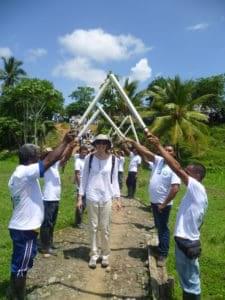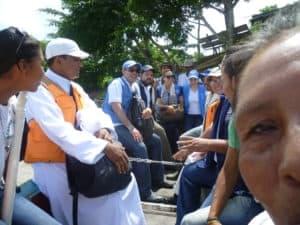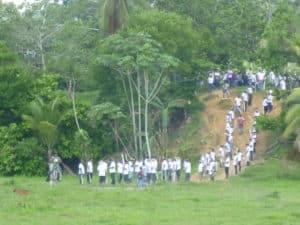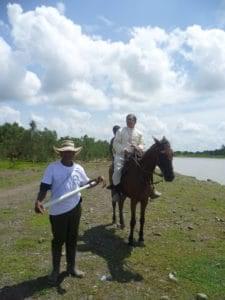In May 2015, the Zenú Indigenous Peoples together with ABColombia, Pastoral Social (social action section) of the Dioceses of Montelibano and SNPS organised an international delegation to the Alto San Jorge Resguardo (Reserve) to celebrate the first anniversary of the legal constitution of the Zenú territories.

The Zenú Indigenous Peoples in the Alto San Jorge Resguardo celebrated the first anniversary of the legal recognition of a large part of their territory by the Colombian Government. In order to help them celebrate this milestone, they invited an international commission comprised of the British Embassy, UNDP (United Nations Development Programme), the Office of the United Nations High Commissioner for Human Rights (OHCHR), the Organisation of American States’ Mission to Support the Peace Process (MAPP – OEA) and ABColombia, who together with the Bishop of Montelibano, the Director of Pastoral Social in Montelibano and the National Secretariat of Pastoral Social travelled to Zenú territory.
This international delegation was accompanied by various local officials including the Colombian National Ombudsman (Defensoria) and INCODER.
It is essential to raise awareness of the precarious situation facing the Zenú Peoples in the Alto San Jorge Resguardo. They have experienced extremely high levels of violence in their territories. Their leaders are continually threatened and have had to be allocated special protection measures by the Colombian Government. The Zenú Peoples report environmental damage to their territory and health problems, which they relate to the Cerro Matoso ferronickel mine that is in their territory. This mine is owned by BHP Billiton and registered on the London Stock Exchange. The Zenú Peoples have taken legal action against Cerro Matoso. It is essential that the Colombian Government and the International Community cooperate with the Zenú Peoples to ensure their rights to land, sustainability in their territory, health and security. Their collective rights must be respected and their concerns in relation to the extractive industry (in particular the Cerro Matoso mine) taken seriously.

It was a great opportunity for me to join this visit. It is really important for the international community to see cases like this first-hand and I certainly came away with a much better understanding of the challenges facing the Zenú people as they endeavour to reclaim and protect their territory. Nicola Davies (UK Embassy in Bogotá)
The UN Office of the High Commissioner for Human Rights in Colombia congratulates the communities and indigenous authorities of the Zenú of Alto San Jorge, department of Cordoba, on the first anniversary of the legal constitution of their Resguardo. The conformation of the Resguardo constitutes an important step in the process of claiming their individual and collective rights, particularly their right to self-governance, to practise and revive their traditions and cultural practices, the right to land and resources, which traditionally belong to them. Likewise, this achievement demonstrates the perseverance and the collective effort of these communities, who have been victims of grave and persistent human rights violations in the context of the internal armed conflict, and have suffered widespread exclusion and discrimination. (UN Office of the High Commissioner for Human Rights, Colombia)
Context
The Colombian Constitutional Court ruled that there were 34 Groups of Indigenous peoples at risk of cultural and physical extinction – one of those groups are the Zenú Indigenous Peoples from the Alto San Jorge Resguardo in Córdoba (a partner of ABColombia). The Court stated that “(…) they have suffered horrendous violations of their collective and individual fundamental rights and have been the victims of breaches of International Humanitarian Law, which has resulted in collective and individual forced displacement.” [1]
Since 2000, there have been countless acts of violence against the members of the Zenú Peoples, due to their endeavours to remain in their ancestral territory. All armed actors have generated violence in their territories. Despite the demobilisation of the Autodefensas Unidas de Colombia (AUC – right wing paramilitaries) the violence continues. The violent acts are attributed to all armed actors who are fighting over the strategic territory for drug trafficking and political control.
In the face of such violence, the Zenú people advocated on local, national and international level, to publicise the severe human rights violations the communities have experienced. According to the Colombian Government the Zenú Peoples are at risk of extinction “due to the severe infringements that they have suffered due to the Colombian internal armed conflict and their social and economic vulnerability, the proliferation of illicit crops, the presence of illegal armed groups in their territory and frequent threats against their leaders, in addition to the presence of the extractive industries.” [2]
The presence of the extractive industry in its territory has generated socio-environmental and health impacts. This has resulted in the Zenú Peoples protesting against the Cerro Matoso mine (a ferronickel mine owned until 2015 by BHP Billiton, a British registered mining company).
On 22 November 2014, the Colombian National Ombudsman (Defensoría) released a report (No. 034-14) on the imminent risk for the municipalities of Montelíbano and Puerto Libertador (Córdoba), which demonstrates the gravity of the situation in the territories inhabited by the indigenous people from the Zenú.
The risk scenario is due to the territorial dispute between the 18th and 58th front of the FARC-EP and the AUC post-demobilisation, the Autodefensas Gaitanistas of Colombia (AGC), (…), evidence of an intensification of death threats against community leaders, indigenous authorities and public servants, forced recruitment and illicit use of children and youth, mobility restrictions, accidents with landmines, forced displacement, confinement of the population, extortions, disappearances and murders.

“The UN Office of the High Commissioner for Human Rights has for several years been accompanying the Zenú communities of Alto San Jorge and the civil society actors that support them, with the aim of contributing to positive changes in their lives. To this end we will continue working in association with the UN Development Programme in Montería, hand in hand with the national and local authorities to ensure that they guarantee them their rights. Moreover, we strive to facilitate a fair and informed dialogue with the company Cerro Matoso SA, which is pursuing activities in the region.” (UN Office of the High Commissioner for Human Rights, Colombia)
Background
The Zenú Resguardo (Reserve) is composed of 47 communities, numbering 3,850 families (19,022 persons) who are distributed across the following areas:
- San José de Uré: 15 communities
- Puerto Libertador: 22 communities
- Montelíbano: 10 communities
The Alto San Jorge region is a vast and extensive territory, rich in agricultural land and in mineral wealth. This natural wealth has attracted illegal armed actors (FARC Guerrilla and Paramilitary Groups) resulting in continuous armed confrontations both between the illegal armed groups as well as with legal armed actors. [3]
These confrontations have gravely affected the local civilian population. The origins of the conflict in the territory of the Zenú Indigenous Resguardo of Alto San Jorge lie in the 1960s, with the arrival of the petroleum companies. The arrival of these companies coincided with the start of the mass displacement of the Zenú indigenous people.
In the 1980s, a small group of indigenous people, concerned about the dispersion of the Zenú and the loss of their cultural identity, initiated a process to identify Zenú Indigenous People in Alto San Jorge; they found families who had settled in the municipalities of Puerto Libertador and Montelíbano.
In 1990, one of the most important Zenú indigenous leaders in the Zenú identification and reunification process was killed. According to one of the Zenú leaders “the Zenú Peoples continue to suffer from direct actions against the life and the dignity of the community at the hands of the illegal armed groups and extractive companies that are present in the region…. The illegal armed actors and multinational companies are involved in the struggle over political and economic power and the exploitation of natural resources.”
In 2000, after bringing various claims before the Colombian government and the Courts of law to have the identity of the Zenú People as well as their lands in the municipalities of Montelibano and Puerto Libertador officially recognised, the first General Assembly of the Zenú of Alto San Jorge took place. By means of the election of a Cabilde Mayor, the Resguardo was officially established. The person that had been elected as Governor during that first General Assembly, resigned within 24 hours after the election, after receiving threats against his life.
After that, the current Governor, Irrael Aguilar Solano, assumed his office, in spite of innumerable threats and severe harassment against him. Following the official recognition of their territory, the Zenú from Alto San Jorge went through a long process to obtain the official documentation to their land title.
Eventually, they received legal recognition in May 2014, 14 years after they had first filed their petitions and had initiated procedures with the authorities. On 27 May 2015, the first anniversary of their recognition was celebrated with the visit of the international commission.

More Information:
• Read ABColombia Report in “Civil Society Voices: Agendas for Peace in Colombia” (2015) (available in English and Spanish).
• Read ABColombia Report in “Self-Protection Mechanisms: Colombian Rural Defenders and Communities” (2016) (available in English and Spanish).
Notes:
[1] Constitutional Court of Colombia, Auto 004 (26 January 2009) [1], own translation.
[2] Acuerdo No. 336 de mayo de 2014- Por el cual se constituye el Resguardo Indígena del Alto San Jorge, pág. 2, own translation.
[3] 18th and 58th front of the FARC-EP and the AUC post-demobilisation, the Autodefensas Gaitanistas of Colombia (AGC).
